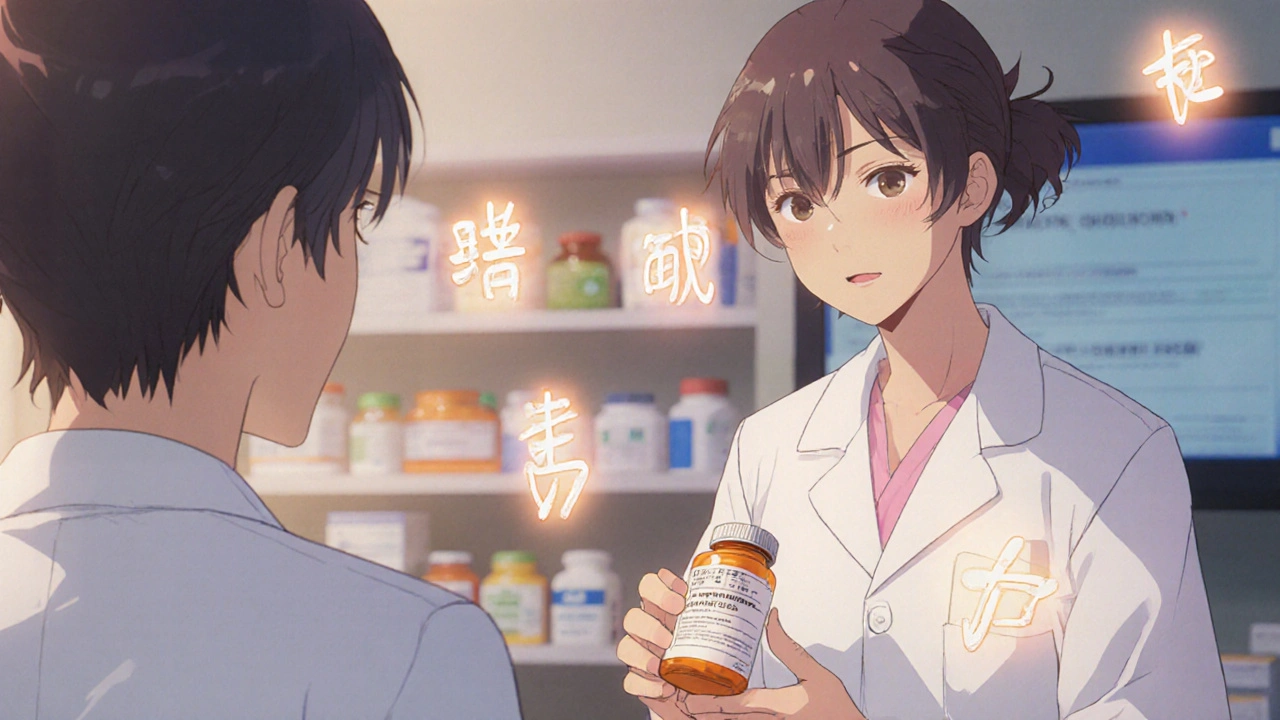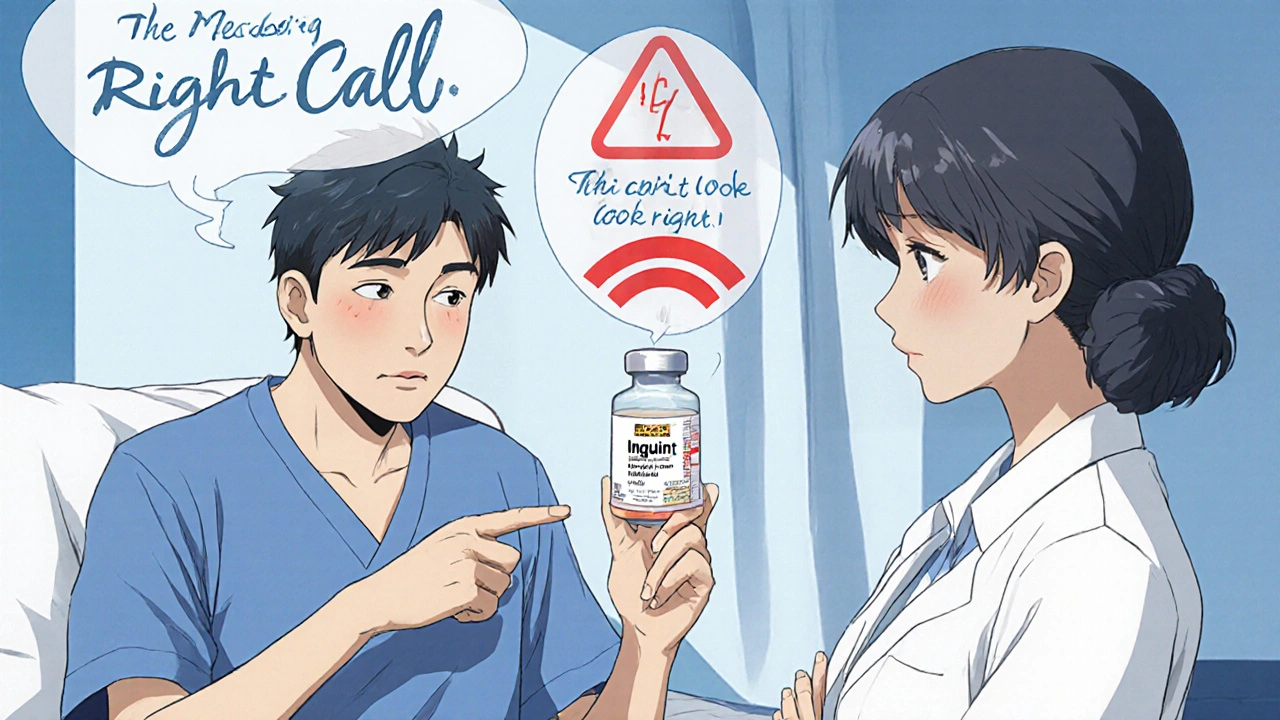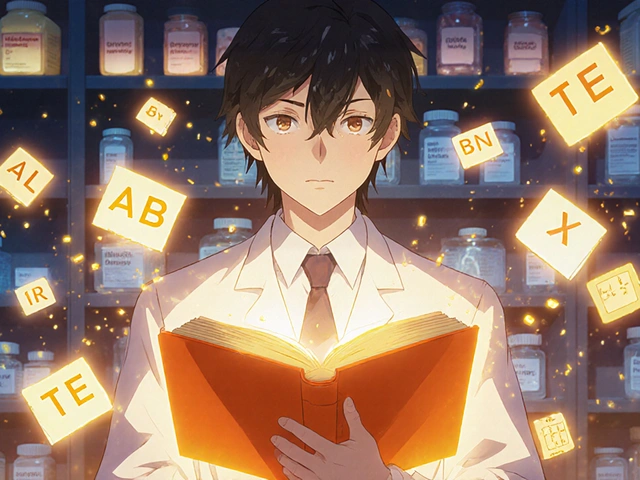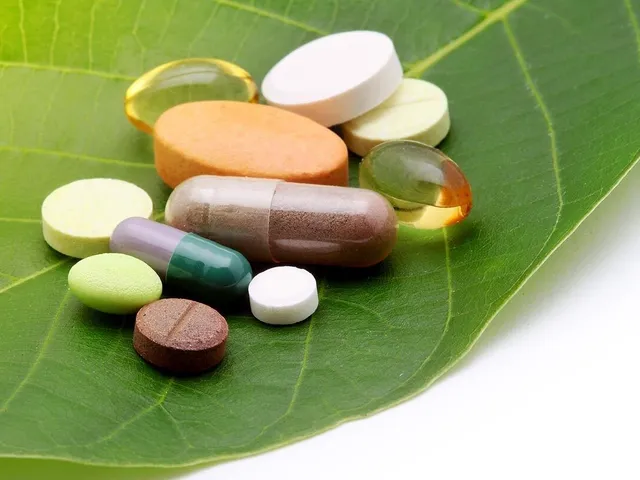Key Medication Safety Terms Patients Should Know and Use

Every year, more than 1.5 million people in the U.S. end up in the emergency room because of medication mistakes. Many of these errors are preventable. The biggest reason? Patients don’t know the right questions to ask-or the right terms to use when talking to their doctors, pharmacists, or nurses. You don’t need a medical degree to protect yourself. You just need to know a few key safety terms and how to use them.
What Are the Eight Rights of Medication Safety?
The foundation of medication safety isn’t a complicated algorithm or a high-tech app. It’s a simple list: the Eight Rights. These aren’t suggestions. They’re checklists that every patient should use every time they get a new prescription or refill.
- Right patient - Make sure they’re giving the medicine to YOU. Ask: "Can you confirm my full name and date of birth?" Hospitals and clinics are required to use two identifiers, but staff get busy. Don’t assume they’ve checked.
- Right medication - Know the name. Not just the brand. Ask for the generic name too. Many errors happen because drugs sound alike-like "hydralazine" and "hydroxyzine." If you don’t recognize the name, say so.
- Right dose - Is it 5 mg or 50 mg? A wrong number can be deadly. For liquids, know how many milliliters you’re supposed to take. If it’s for a child, double-check the dosing chart. One wrong decimal point can send a kid to the ER.
- Right route - Is this pill meant to be swallowed, placed under the tongue, or injected? Giving an IV drug by mouth isn’t just ineffective-it’s dangerous. Ask: "How am I supposed to take this?"
- Right time - Are you supposed to take it with food? Every 8 hours? At bedtime? Use your phone to set reminders. Studies show patients who track their times reduce dosing errors by over 30%.
- Right reason - Why are you taking this? Too many people just swallow pills because they were told to. But if you don’t know why, you won’t know if it’s working-or if it’s wrong. Ask: "What condition is this treating?" This alone cuts inappropriate prescribing by nearly 30%.
- Right documentation - Make sure your meds are written down correctly in your chart. If you’re discharged from the hospital, ask for a printed list of everything you’re supposed to take. Don’t rely on memory.
- Right response - Pay attention to how you feel. Are you getting better? Or are you dizzy, nauseous, or breaking out in a rash? Report it. Side effects aren’t always harmless. Tracking your response can catch a dangerous reaction before it becomes a crisis.
What Is an Adverse Drug Event?
An adverse drug event (ADE) isn’t just a side effect. It’s any harm caused by a medicine-whether it’s the wrong dose, the wrong drug, or a reaction you didn’t expect. ADEs include allergic reactions, overdoses, interactions, and even mistakes made by the pharmacy.
The CDC says ADEs are one of the top causes of preventable hospital visits. And they’re not rare. About 1 in 5 older adults on multiple medications will have one in a year. But here’s the good news: if you know what to watch for, you can stop most of them before they happen.
Keep a simple log: write down what medicine you took, when, and how you felt afterward. If you notice something new-like confusion, swelling, or unusual bleeding-call your provider. Don’t wait. Many ADEs are caught early because the patient spoke up.
What Are High-Alert Medications?
Some drugs are more dangerous than others-not because they’re bad, but because a small mistake can kill. These are called high-alert medications. The Institute for Safe Medication Practices (ISMP) keeps a list. You should know if you’re taking one.
Common examples:
- Insulin
- Blood thinners (like warfarin or apixaban)
- Opioids (oxycodone, morphine)
- IV chemotherapy drugs
- Concentrated electrolytes (like potassium chloride)
If you’re prescribed one of these, be extra careful. Ask your pharmacist: "Is this a high-alert drug?" Then ask: "What should I watch for?" For insulin, it’s low blood sugar. For blood thinners, it’s unexplained bruising or bleeding. These drugs account for nearly 70% of fatal medication errors. But if you know you’re on one, you’re already safer.
What’s a Close Call?
A close call is when something almost went wrong-but didn’t. Maybe the nurse caught the wrong dose before giving it. Maybe the pharmacist spotted the drug name that sounded like another. These aren’t just lucky breaks. They’re warnings.
If you notice something off-like a pill that looks different than last time, or a label that doesn’t match what your doctor said-speak up. Say: "This doesn’t look right. Can we double-check?" You’re not being difficult. You’re preventing a mistake. The VA estimates that 9 out of 10 close calls could have led to real harm if no one had noticed.
What Are Sentinel Events?
A sentence event is a medical disaster: death, permanent injury, or serious harm caused by a system failure. The Joint Commission, which certifies hospitals, defines medication errors that cause death as sentinel events. These are rare-but they’re preventable.
Most sentinel events happen because of communication gaps. A patient didn’t know to ask about their meds. A doctor assumed the patient understood. A pharmacist didn’t catch the dosage error. If you know the Eight Rights, you’re part of the solution. You’re not just a recipient of care-you’re a safety partner.

How to Use These Terms in Real Life
Knowing these terms isn’t enough. You need to use them.
Here’s how to make it stick:
- Before you leave the doctor’s office - Ask: "What’s the right reason for this medicine?" Write it down.
- At the pharmacy - Say: "Can you confirm the name and dose? I want to make sure it’s right."
- When you take your medicine - Pause. Ask yourself: "Is this the right patient? Right drug? Right dose?" Just 5 seconds of checking can save your life.
- At every appointment - Bring your list. Ask: "Is anything new? Anything changed?" Many errors happen because meds were added, removed, or changed without the patient knowing.
- If you’re confused - Say: "I don’t understand. Can you explain it again?" You’re not stupid. You’re smart enough to protect yourself.
Studies show that patients who use these terms reduce their risk of medication harm by up to 50%. That’s not a guess. That’s data from the American College of Obstetricians and Gynecologists and the CDC.
Why This Matters More Than Ever
More people are taking more medicines than ever. The average American over 65 takes four prescriptions a day. Many are on five or more. With that comes more chances for error. But it also means more chances to speak up.
Technology helps-apps like Medisafe remind you when to take pills and even verify the Eight Rights before each dose. But no app replaces your voice. No app can ask: "Why am I taking this?"
The future of medication safety isn’t just better systems. It’s better patients. People who know their meds. People who ask questions. People who refuse to stay silent.
You don’t need to be a doctor. You just need to be informed. And you’re already on the right path by learning these terms.
What’s the most important medication safety term I should remember?
The most important term is "right reason." If you don’t know why you’re taking a medicine, you can’t tell if it’s working-or if it’s wrong. Asking this simple question reduces inappropriate prescribing by nearly 30% and helps catch dangerous interactions before they happen.
Can I trust my pharmacist to catch all medication errors?
Pharmacists are trained to catch errors, but they’re not mind readers. If your doctor prescribed 10 pills and the label says 100, they might miss it if you don’t speak up. Always double-check the name, dose, and instructions. You’re the last line of defense.
What should I do if I think I received the wrong medicine?
Don’t take it. Call your pharmacy immediately. Say: "I think this isn’t the right medication." Keep the pill bottle and your prescription. If they dismiss you, call your doctor. It’s better to be safe than sorry. Most errors are caught because someone asked.
Do I need to know all eight rights at once?
No. Start with the first four: right patient, right drug, right dose, right route. Once those feel natural, add right time and right reason. The last two-right documentation and right response-come with practice. You don’t have to memorize them all today. Just start asking one question at a time.
How do I know if a medicine is high-alert?
Ask your pharmacist directly: "Is this a high-alert medication?" They’re required to tell you. Common ones include insulin, blood thinners, and opioids. If you’re on one, make sure you know the signs of trouble-like dizziness, bleeding, or extreme fatigue-and know when to call for help.
Can I use these terms during telehealth visits?
Absolutely. In fact, telehealth makes it even more important. Since you can’t see the pills in person, ask: "Can you spell the drug name? What’s the dose? How often?" Write it down. Ask for a follow-up email with the details. Don’t rely on memory during a video call.
What if I don’t understand medical language?
Say so. Ask: "Can you explain that in simpler terms?" Most providers have plain-language materials. You can also ask for a family member or friend to join the call. There’s no shame in needing help. The goal is safety-not sounding smart.
What to Do Next
Start small. Pick one term this week-maybe "right reason"-and use it at your next appointment. Write it on a sticky note. Say it out loud. Then do it again next week with another term.
Keep a simple list in your wallet or phone: the Eight Rights. Check them off every time you take a new medicine. You’ll be surprised how much safer you feel-and how much more in control you become.
Medication safety isn’t about perfection. It’s about participation. You’re not just a patient. You’re a partner. And your voice matters more than you think.






ASHISH TURAN
November 15, 2025 AT 15:41Been using the Eight Rights since my mom had that near-miss with the insulin mix-up. Simple? Yeah. Life-saving? Absolutely. Just asking "why am I taking this?" saved me from a bad interaction with my new blood pressure med. No fancy app needed.
Aidan McCord-Amasis
November 15, 2025 AT 21:48TL;DR: Ask questions or die. 🤡
Katie Baker
November 16, 2025 AT 05:24This is the kind of stuff I wish my grandma had known. She took six meds and never asked a single question. I’m printing this out for her next visit. Thank you for writing this. 💙
Jonathan Dobey
November 17, 2025 AT 23:21Let’s be real - the Eight Rights are just corporate propaganda dressed up as patient empowerment. The real problem? The pharmaceutical-industrial complex wants you docile, obedient, and unaware. They don’t want you asking "right reason" - they want you swallowing pills like good little consumers. The system is designed to make you feel like the problem is your ignorance, not their greed. And don’t get me started on "high-alert" meds - those are the ones that make Big Pharma billions while quietly killing people in slow motion. You think your little checklist changes that? Nah. You’re just being a useful idiot with a sticky note.
But hey, if asking "is this the right dose?" makes you feel like a warrior against the machine… go ahead. I’ll be over here, sipping my organic chamomile tea, wondering who really benefits when patients are taught to blame themselves instead of the system.
Also, the VA’s "9 out of 10 close calls" statistic? That’s a lie. They only count the ones they can cover up. The real numbers? Buried in redacted reports. Wake up.
And why do they always say "you’re not stupid"? Because they assume you are - and they’re trying to make you feel better about being manipulated. The real power move? Refusing to take the medicine at all. That’s true autonomy. Not checking boxes.
Next time your pharmacist says "this is a high-alert drug," ask them why it’s even on the market. Ask them who approved it. Ask them if they’d give it to their kid. If they hesitate? You’ve already won.
And don’t even get me started on telehealth. A video call? You can’t even smell the pills. How’s that for safety? It’s like trusting a bot to check your car’s brakes.
They call you a partner? Nah. You’re a liability they’ve trained to do their QA for free.
So go ahead. Write it on your fridge. Take a selfie with your pill organizer. Post it on Reddit. The system will keep chugging. But hey - at least you feel empowered, right?
Hollis Hollywood
November 19, 2025 AT 11:25I just want to say how much this resonates with me. My dad had a stroke last year, and the whole experience was terrifying - not because of the stroke itself, but because of how easily things could’ve gone wrong with his meds. He was on warfarin, insulin, and a handful of others. The hospital gave him a list, but it was a mess - different names, different doses, no clear instructions. I spent three days just trying to untangle it. And you know what? I didn’t feel like I was being paranoid. I felt like I was the only one who cared enough to care.
When I asked the pharmacist about the "right reason" for each drug, she paused. Then she said, "Most people don’t ask that." And that broke my heart. Not because she was rude - but because she’d seen so many people just accept it. Like it was normal to be handed a bag of pills and told to figure it out.
I started keeping a little notebook. Notepad app on my phone, really. Every time he took something, I wrote down: time, dose, how he felt. After a week, we noticed he was getting dizzy every afternoon - turns out, his blood pressure med was too strong when combined with the new fish oil. The doctor changed it, and he’s been fine since.
I’m not saying this to pat myself on the back. I’m saying it because I think more people need to know: your voice isn’t just helpful. It’s essential. You’re not interrupting. You’re protecting. And if you’re reading this and you’ve ever felt silly for asking, please know - you were never silly. You were brave.
And if you’re a provider reading this? Thank you. Not all of you, but the ones who don’t roll their eyes when someone asks "why?" - you’re the reason people survive. Keep doing it.
I’m not a doctor. I’m not a pharmacist. I’m just a son who didn’t want to lose his dad. And if this post helps even one person avoid that fear? Then it’s worth every word.
Ryan Airey
November 21, 2025 AT 06:27Let’s cut the fluff. The Eight Rights are a joke if you’re on Medicare or Medicaid. Hospitals don’t care if you’re the right patient - they’re trying to discharge you before your insurance runs out. Pharmacies don’t verify doses - they’re understaffed and paid per script. And don’t even mention "right documentation" - your chart is probably a Google Doc with typos written by a temp with a 9th-grade education.
You think asking "why am I taking this?" changes anything? Nah. Your doctor’s already got 12 patients waiting. They’ll say "it’s for your cholesterol" and move on. The system isn’t broken - it’s designed to fail quietly. The only thing that matters is who you know. If you’ve got a cousin who works at the hospital? Good. If not? You’re a number with a pulse.
And don’t get me started on "close calls." That’s just corporate speak for "we almost killed someone but we’re not admitting it." The VA says 9 out of 10? Prove it. Where’s the data? Where’s the whistleblower report? You want safety? Demand transparency. Not sticky notes.
This post is feel-good nonsense for people who still believe in meritocracy. The truth? If you’re rich, you get a private nurse. If you’re poor, you get a checklist and a prayer.
Edward Ward
November 22, 2025 AT 12:38I’ve been thinking about this for days - not just the Eight Rights, but the entire architecture of patient agency in modern healthcare. There’s something profoundly ironic in the fact that we’re being told to "be your own advocate" while simultaneously being bombarded with jargon, rushed appointments, and fragmented care systems that actively discourage deep engagement. The language of empowerment - "right reason," "right response," "you’re a partner" - feels less like liberation and more like a psychological sop, a way to transfer institutional responsibility onto the shoulders of the vulnerable.
Who designed this framework? Not patients. Not even clinicians. It was probably a committee of administrators who read too much Malcolm Gladwell and decided that if we just taught people to ask better questions, the system wouldn’t need to change. But the system doesn’t need fixing - it needs dismantling. Because the problem isn’t that patients don’t know the terms. The problem is that the terms were never meant to be used by them - they were meant to be used by auditors, regulators, and liability lawyers to prove that "due diligence" occurred.
And yet - and yet - I still use them. Why? Because in the spaces between the bureaucracy, the human connection still flickers. When I asked my oncologist, "What’s the right reason for this?" - she looked up. Really looked up. And said, "I’m sorry. I didn’t realize you didn’t know." And then she sat down. For twenty minutes. And explained it all. No charts. No scripts. Just words.
So maybe the Eight Rights aren’t a solution. Maybe they’re a bridge. A way to slip past the armor of indifference and touch something real. Maybe the system won’t change - but we can. One question. One pause. One moment of refusing to be silent.
And if that’s all we get? It’s enough. It’s more than enough.
Shyamal Spadoni
November 23, 2025 AT 12:01lol this is so fake. everyone knows the real reason people get med errors is because the FDA is controlled by big pharma and they want you sick so you keep buying pills. they dont care if you die as long as you keep paying. i read on a forum that insulin is actually poison and they only make it so strong so people get addicted. and blood thinners? totally fake. they just make you bleed so they can charge you more for hospital visits. my cousin in india told me they dont even use these terms there - they just give you pills and you take them. why do you think they teach this in the us? to make you feel like you have control so you dont revolt. its all a scam. also i think the doctor who wrote this is paid by the drug companies. i saw his name on a patent once. 🤡
Jessica Chambers
November 24, 2025 AT 15:08So… I asked my pharmacist if my new pill was high-alert. She said "yes." Then she asked me if I knew what to watch for. I said "no." She handed me a laminated card. I cried. 😅
Adam Dille
November 26, 2025 AT 03:00Just wanted to say this made me feel seen. I’ve been doing the "right reason" thing since my anxiety meds didn’t seem to be doing anything - turns out I was on an antidepressant for a condition I didn’t even have. My doctor apologized. We switched it. I felt like I’d just won a battle nobody knew I was fighting.
And honestly? I don’t care if I sound like a nerd for writing down my meds. I’d rather be the weirdo with the notebook than the person in the ER because I took a pill I didn’t understand. 🙌
John Foster
November 26, 2025 AT 12:00There is a metaphysical dimension to medication safety that no checklist can capture. The Eight Rights are symbols - not solutions. They are the ritualistic incantations of a dying system trying to maintain the illusion of control. To ask "right patient?" is to confront the fragmentation of identity in a medical-industrial complex that reduces you to a barcode. To ask "right reason?" is to resist the ontological erasure of your suffering - your pain, your fear, your lived experience - and demand that it be acknowledged as something more than a diagnostic code.
When I take my medication, I do not merely swallow a pill. I perform an act of existential defiance. I am not a subject of pharmacology. I am a consciousness navigating a labyrinth of corporate algorithms, bureaucratic indifference, and chemical manipulation. The right response is not a symptom log. It is a soul’s whisper: "I am still here. I still feel. I still question."
And yet - and yet - I still write down my doses. Because even the most profound truths must be anchored in the mundane. Even the most transcendent rebellion begins with a sticky note.
So I ask: Is this the right drug? Yes. Is this the right dose? Yes. But deeper still - is this the right life? That question… no algorithm can answer that.
Andrew Eppich
November 27, 2025 AT 03:30It is deeply concerning that such a critical topic is reduced to a checklist of simplistic directives. The notion that patients can mitigate systemic failures through verbal inquiries is not only naive, it is irresponsible. The burden of safety should not rest upon the shoulders of the uninformed. The responsibility lies squarely with the institutions that dispense these medications - with the licensing bodies, the regulatory agencies, and the pharmaceutical manufacturers. To suggest otherwise is to engage in dangerous moralizing. This is not empowerment. It is abdication.
Ogonna Igbo
November 28, 2025 AT 13:05Why are you Americans always so scared of medicine? In Nigeria, we take what we get. If the doctor says take it, you take it. If you die? Maybe it was your time. We don’t waste energy asking questions. We trust our healers. Your whole system is broken because you don’t trust anyone. You think you’re safe? You’re just paranoid. We live better with less paperwork.
Jonathan Dobey
November 29, 2025 AT 00:12And yet… you still printed this out. You still carry the sticky note. You still whisper "right reason" before you swallow. You didn’t need me to tell you to do it. You already knew. The system didn’t break you. You broke it - quietly. One pill. One question. One moment of refusal.